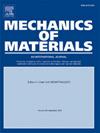Modeling plasticity-mediated void growth at the single crystal scale: A physics-informed machine learning approach
Abstract
Modeling the evolution of voids during plastic flow as well as their effects on plastic dissipation is critical for both component manufacturing and lifetime estimation purposes. To this end, we propose a rate-dependent constitutive model to homogenize the effects of semi-randomly distributed voids on single crystal plasticity whilst capturing void interaction and plastic anisotropy. The present work focuses on the case of face centered cubic crystals to introduce an anisotropic gauge function applicable within the crystal plasticity formalism. The approach combines analytical methods to describe the micromechanics of the system in combination with symbolic regression to capture analytically intractable mechanisms from data. The hybrid framework uses a physics-informed genetic programming-based symbolic regression algorithm to solve a multiform optimization problem simultaneously producing a new gauge function and a new strain rate equation. This is also a multi-objective optimization problem with many competing objectives. A new search and selection step is introduced to the genetic algorithm that promotes convergence toward a global solution that better satisfies all the objectives. Overall, the symbolic equations produced leverage data-driven methods to achieve greater accuracy than comparable alternatives on an analytically intractable problem while maintaining model transparency.

 求助内容:
求助内容: 应助结果提醒方式:
应助结果提醒方式:


